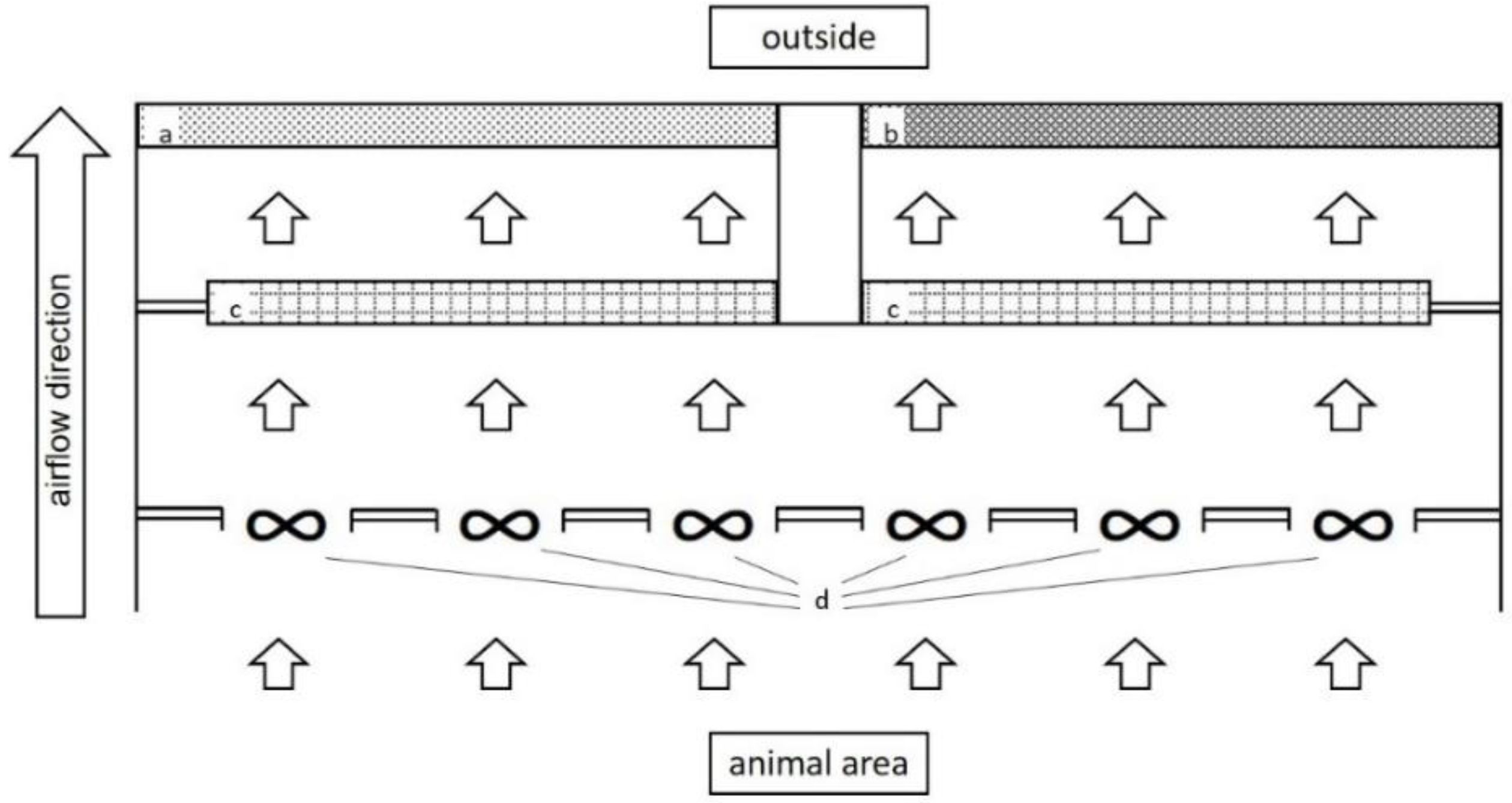Suitability of Different Filling Materials for a Biofilter at a Broiler Fattening Facility in Terms of Ammonia and Odour Reduction
Abstract
1. Introduction
2. Experiments
3. Results and Discussion
4. Conclusions
- Both the root wood and honeycombed paper pad material helped to mitigate odour concentrations of exhaust air by up to 51%.
- The honeycombed paper pad filter provided better results, presumably due to lower inherent odour and lower fungal growth.
- Further investigation according to the VERA protocol [5] is needed for a long-term stability evaluation of the honeycombed paper pad material, as well as for objective comparability to other systems.
Author Contributions
Funding
Acknowledgments
Conflicts of Interest
References
- Tista, M.; Gager, M.; Gaisbauer, S.; Ullrich, B. European Union Emission Inventory Report 1990–2017 under the UNECE Convention on Long-Range Transboundary Air Pollution (LRTAP); Publications Office of the European Union: Luxembourg, 2019; ISBN 978-92-9480-078-7. [Google Scholar]
- Valli, L.; Moscatelli, G.; Labartino, N. Odour emissions from livestock production facilities. Chem. Eng. Trans. 2008, 15, 239–246. [Google Scholar]
- Loyon, L.; Burton, C.H.; Misselbrook, T.; Webb, J.; Philippe, F.X.; Aguilar, M.; Doreau, M.; Hassouna, M.; Veldkamp, T.; Dourmad, J.Y.; et al. Best available technology for European livestock farms: Availability, effectiveness and uptake. J. Environ. Manag. 2016, 166, 1–11. [Google Scholar] [CrossRef]
- Grimm, E. (Ed.) Exhaust Air Treatment Systems for Animal Housing Facilities. Techniques-Performance-Costs; KTBL: Darmstadt, Germany, 2008; ISBN 9783939371601. [Google Scholar]
- The International VERA Secretariat. VERA TEST PROTOCOL for Livestock Housing and Management Systems. Version 3:2018-09; The International VERA Secretariat: Delft, The Netherlands, 2018. [Google Scholar]
- Van der Heyden, C.; Demeyer, P.; Volcke, E.I.P. Mitigating emissions from pig and poultry housing facilities through air scrubbers and biofilters: State-of-the-art and perspectives. Biosyst. Eng. 2015, 134, 74–93. [Google Scholar] [CrossRef]
- Melse, R.W.; Hol, J.M.G. Biofiltration of exhaust air from animal houses: Evaluation of removal efficiencies and practical experiences with biobeds at three field sites. Biosyst. Eng. 2017, 159, 59–69. [Google Scholar] [CrossRef]
- Chen, L.; Hoff, S.; Cai, L.; Koziel, J.; Zelle, B. Evaluation of Wood Chip-Based Biofilters to Reduce Odor, Hydrogen Sulfide, and Ammonia from Swine Barn Ventilation Air. J. Air Waste Manag. Assoc. 2009, 59, 520–530. [Google Scholar] [CrossRef]
- Nicolai, R.E.; Janni, K.A. Effect of Biofilter Retention Time on Emissions from Dairy, Swine and Poultry Buildings. In Proceedings of the ASAE Annual International Meeting, Toronto, ON, Canada, 18–22 July 1999. [Google Scholar]
- Harmon, J.D.; Hoff, S.J.; Rieck-Hinz, A.M. Animal Housing—Biofilters Overview. Agric. Environ. Ext. Publ. 2014, 210. Available online: http://lib.dr.iastate.edu/extension_ag_pubs/210 (accessed on 1 December 2019).
- Ogink, N.W.M.; Melse, R.W.; Mosquera, J. Multi-Pollutant and One-Stage Scrubbers for Removal of Ammonia, Odor, and Particulate Matter from Animal House Exhaust Air. Livest. Environ. VIII 2008, 701P0408, 269–276. [Google Scholar]
- Huang, D. Odour and Gas Emissions, Odour Impact Criteria, and Dispersion Modelling for Dairy and Poultry Barns. Ph.D. Thesis, University of Saskatchewan, Saskatoon, SK, Canada, 2018. [Google Scholar]
- Pedersen, S. Forced Ventilation. In CIGR Handbook of Agricultural Engineering II. Animal Production & Aquacultural Engineering,1999; CIGR: Liège, Belgium, 1999; pp. 68–88. [Google Scholar]
- Hiller, P.; Pieper, H.; Schierhold, S.; Meyer, A. Hähnchenhaltung. Leitlinien für die gute landwirtschaftliche Praxis in der Hähnchenhaltung; Landwirtschaftskammer Niedersachsen: Lower Saxony, Germany, 2016. [Google Scholar]
- Schmithausen, A.J.; Trimborn, M.; Büscher, W. Methodological Comparison between a Novel Automatic Sampling System for Gas Chromatography versus Photoacoustic Spectroscopy for Measuring Greenhouse Gas Emissions under Field Conditions. Sensors 2016, 16, 1638. [Google Scholar] [CrossRef] [PubMed]
- Luftbeschaffenheit—Bestimmung der Geruchsstoffkonzentration mit dynamischer Olfaktometrie; Deutsche Fassung EN 13725:2003; DIN EN 13725:2003-07; Beuth Verlag GmbH: Berlin, Germany, 2003.

| Parameter | Raw Gas | Root Wood | Paper Pads |
|---|---|---|---|
| Ammonia (ppm) | 3.99 | 1.14 (71%) | 1.29 (68%) |
| Odour (OUE m−3) | 256 | 159 1 (38%) | 125 1 (51%) |
© 2019 by the authors. Licensee MDPI, Basel, Switzerland. This article is an open access article distributed under the terms and conditions of the Creative Commons Attribution (CC BY) license (http://creativecommons.org/licenses/by/4.0/).
Share and Cite
Strohmaier, C.; Krommweh, M.S.; Büscher, W. Suitability of Different Filling Materials for a Biofilter at a Broiler Fattening Facility in Terms of Ammonia and Odour Reduction. Atmosphere 2020, 11, 13. https://doi.org/10.3390/atmos11010013
Strohmaier C, Krommweh MS, Büscher W. Suitability of Different Filling Materials for a Biofilter at a Broiler Fattening Facility in Terms of Ammonia and Odour Reduction. Atmosphere. 2020; 11(1):13. https://doi.org/10.3390/atmos11010013
Chicago/Turabian StyleStrohmaier, Carolina, Manuel S. Krommweh, and Wolfgang Büscher. 2020. "Suitability of Different Filling Materials for a Biofilter at a Broiler Fattening Facility in Terms of Ammonia and Odour Reduction" Atmosphere 11, no. 1: 13. https://doi.org/10.3390/atmos11010013
APA StyleStrohmaier, C., Krommweh, M. S., & Büscher, W. (2020). Suitability of Different Filling Materials for a Biofilter at a Broiler Fattening Facility in Terms of Ammonia and Odour Reduction. Atmosphere, 11(1), 13. https://doi.org/10.3390/atmos11010013






